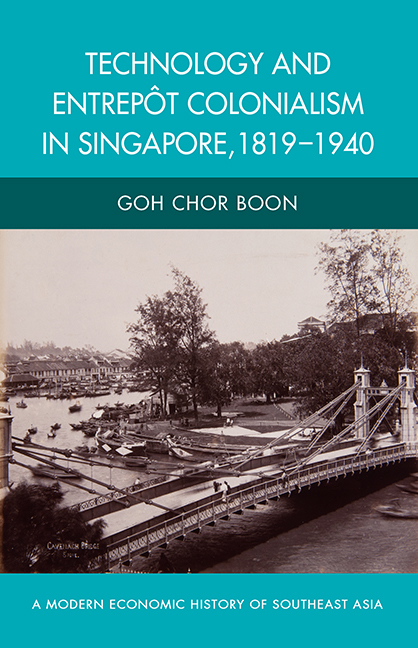Book contents
- Frontmatter
- Contents
- List of Figures and Tables
- Notes on Currency
- Introduction
- 1 Technology and the British Empire
- 2 Pioneers of Change: Entrepreneurs and Engineers
- 3 Maritime Technology and Development of the Port
- 4 Introducing Technological Systems
- 5 Sanitation and Public Health
- 6 Agriculture and Colonial Science
- 7 Food and Singapore Cold Storage
- 8 Politics of Imperial Education
- 9 Technology Transfer and Limited Industrial Growth
- Conclusion
- Bibliography
- Index
Introduction
Published online by Cambridge University Press: 21 October 2015
- Frontmatter
- Contents
- List of Figures and Tables
- Notes on Currency
- Introduction
- 1 Technology and the British Empire
- 2 Pioneers of Change: Entrepreneurs and Engineers
- 3 Maritime Technology and Development of the Port
- 4 Introducing Technological Systems
- 5 Sanitation and Public Health
- 6 Agriculture and Colonial Science
- 7 Food and Singapore Cold Storage
- 8 Politics of Imperial Education
- 9 Technology Transfer and Limited Industrial Growth
- Conclusion
- Bibliography
- Index
Summary
When the city-state of Singapore gained its independence in 1965, there was the question of whether the government should bring down the statue of Sir Stamford Raffles, the “founder” of Singapore and standing proudly in front of the iconic Victoria Memorial Hall. The statue was unveiled when the colony celebrated the fiftieth anniversary of the reign of Queen Victoria in 1887. In the words of Lee Kuan Yew:
Investors wanted to see what a new socialist government in Singapore was going to do to the statue of Raffles. Letting it remain would be a symbol of public acceptance of the British heritage and could have a positive effect. I had not looked at in that way, but was quite happy to leave this monument because he was the founder of modern Singapore. If Raffles had not come here in 1819 to establish a trading post, my great-grandfather would not have migrated to Singapore from Dapu county in Guangdong province, southeast China. The British created an emporium that offered him, and many thousands like him, the opportunity to make a better living than in their homeland which was going through turmoil and chaos as the Qing dynasty declined and disintegrated.
For many former colonies of the British and other European empires, the memory of the colonial period is often a painful one, a national humiliation of conquest, military occupation and subservience. Independence was more often than not greeted as a celebration of liberation. For the island-state of Singapore, British colonialism and its ideology of “civilizing mission” did provide the thousands of Chinese, Indians, Malays and Europeans “the opportunity to make a better living”. Together with the British and other European entrepreneurs, engineers, missionaries, and municipal administrators, these forefathers laid a strong foundation of a modern city. The story of their effort started one morning in the month of January of the year 1819.
On 29 January 1819, Thomas Raffles landed on the white sandy beach of Singapore, near the mouth of the Singapore River. According to an eyewitness, Raffles was accompanied by two white men and a sepoy who carried a musket.
- Type
- Chapter
- Information
- Publisher: ISEAS–Yusof Ishak InstitutePrint publication year: 2013



